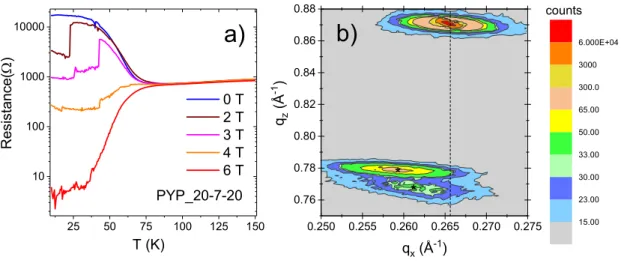Supporting Online Material: Granular superconductivity and
charge/orbital order in YBa
2Cu
3O
7/manganite trilayers
J. Khmaladze1, S. Sarkar1, M. Soulier1, F. Lyzwa1, R. de Andres Prada1, E. Perret1,2, B.P.P.
Mallett3, M. Minola4, B. Keimer4 and C. Bernhard1
1Department of Physics and Fribourg Center for Nanomaterials, University of Fribourg, Chemin du Musée 3, 1700 Fribourg, Switzerland.
2Laboratory for Advanced Fibers, Empa, Swiss Federal Laboratories for Materials Science and Technology, Lerchenfeldstrasse 5, 9014 St. Gallen, Switzerland.
3The MacDiarmid Institute and the Dodd Walls Centre for Photonic and Quantum Technologies, Photon Factory, University of Auckland, 38 Princes St, Auckland, New Zealand.
4Max-Planck-Institut für Festkörperforschung, Heisenbergstrasse 1, 70569 Stuttgart, Germany.
Influence of the strain from the substrate on the insulator-superconductor
transition (IST)
We studied how the strain from the lattice mismatch with the substrate influences the magnetic-field-induced IST transition. Figure S1(a) shows the corresponding R-T curves for different in-plane magnetic fields for a PLCMO(20nm)/YBCO(7nm)/PLCMO(20nm) trilayer that has been grown on a SrLaAlO4 (SLAO) substrate. The latter substrate has a considerably smaller
in-plane lattice parameter with a(SLAO)=0.375 nm than the bulk lattice parameter of PLCMO with a(PLCMO)=0.386 nm and thus gives rise to a large compressive strain of a/a-2.8%.
For the nominally identical PYP trilayer in Fig. 1(a) of the paper the LSAT substrate with
a(LSAT)=0.387 Å is much better lattice matched with PLCMO and yields only a weak tensile
strain of a/a + 0.3%.
The strain relaxation of the PLCMO layers of the trilayer on SLAO has been studied in terms of a reciprocal space map (RSM) around the (0 1 3) and (0 1 11) structural Bragg peaks of PLCMO and SLAO, respectively, that was obtained with a 4-cycle Rigaku Smartlab diffractometer with a 9 kW rotating Cu K anode source. Figure S1(b) shows that the (0 1 3)
reflex of PLCMO exhibits a double-peak structure that is characteristic of different strain states of the lower and upper PLCMO layers. The narrower peak has most likely a dominant contribution from the upper PLCMO layer (on top of YBCO) that is almost fully relaxed with lattice parameters a=3.86(1) Å and c=3.851(4) Å. The broadened peak (with average lattice parameters a=0.383(1) nm and c=0.3910(5) nm) is assigned to the lower PLCMO layer and arises from the region next to the SLAO substrate which accommodates most of the strain relaxation. The weaker intensity of this broadened peak, as compared to the narrow peak, suggests that the thickness of the region in which most of the that strain relaxation region occurs is even smaller than the one of the lower PLCMO layer (of 20 nm).
Figure S1(a) shows that the R-T curves of the PYP trilayer on SLAO closely resemble the ones of the corresponding PYP trilayer on LSAT in Fig. 1(a) of the paper. In particular, they both exhibit a steep resistive upturn below about 80K in zero magnetic field and a regular superconducting transition at high fields. This suggests that the magnetic-field-induced IST of these PYP trilayers is not primarily caused by the strain from the substrate and/or related defects that may form during the relaxation process.
Figure 1: (a) Magneto-resistance versus temperature curves of a PLCMO(20nm) /
YBCO(7nm) / PLCMO(20nm) trilayer grown on a SrLaAlO4 (SLAO) substrate. (b) Reciprocal
space map (RSM) around the (0 1 3) and (0 1 11) structural Bragg peaks of PLCMO and SLAO, respectively. The (0 1 3) reflex of PLCMO exhibits a double-peak structure for which the maxima are marked by the black stars. They indicate that the bottom and top PLCMO layers are in different strain states.
0.250 0.255 0.260 0.265 0.270 0.275 0.76 0.78 0.80 0.82 0.84 0.86 0.88
